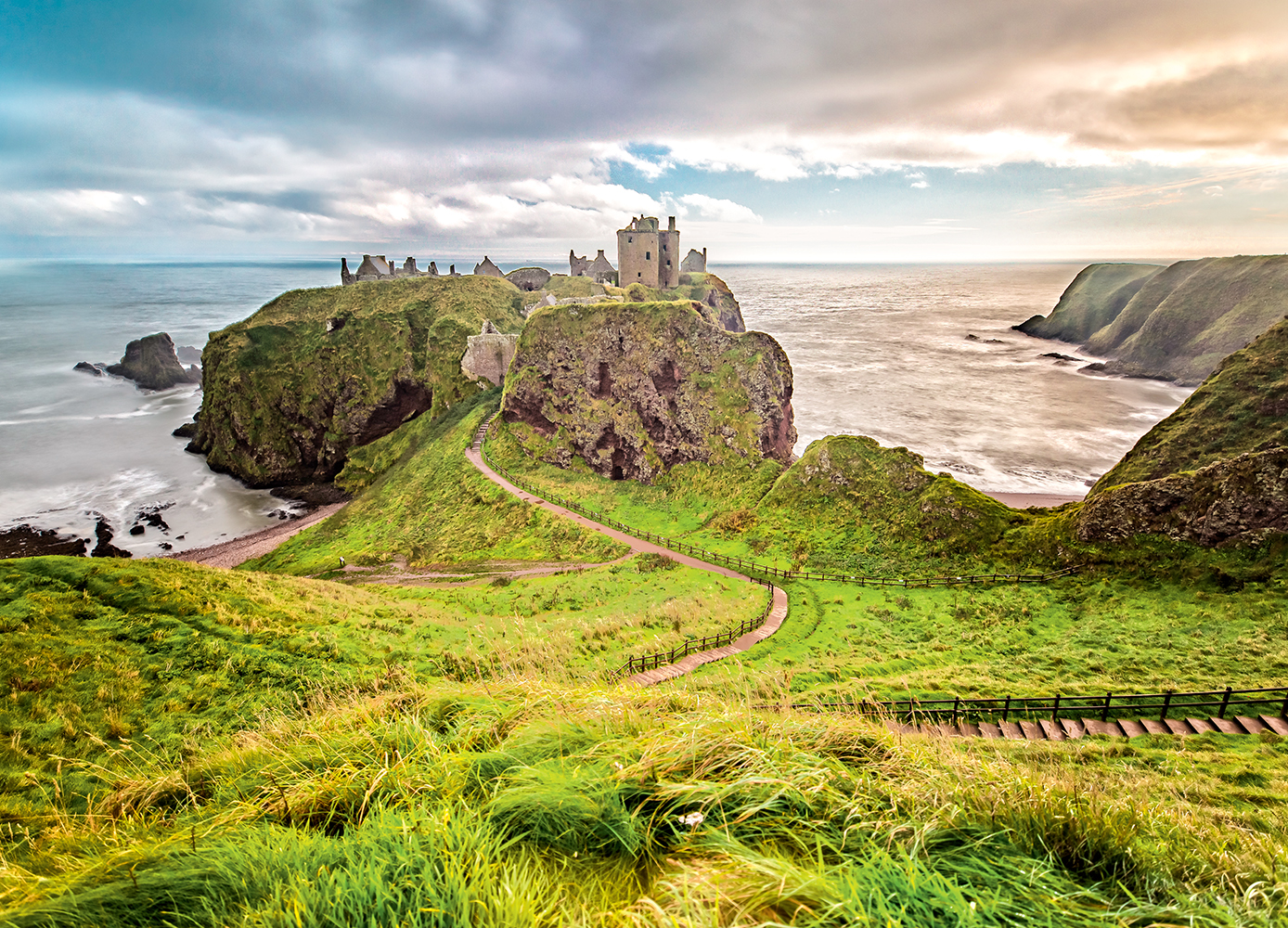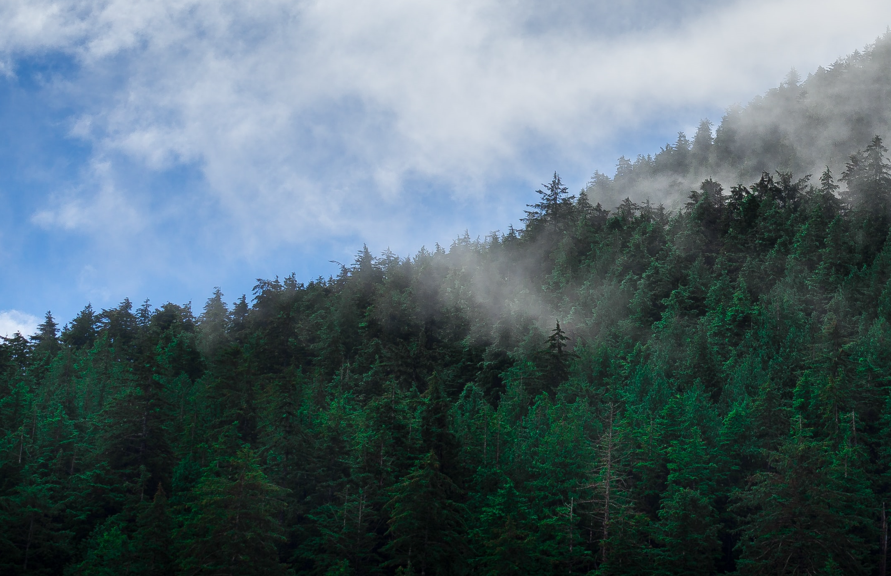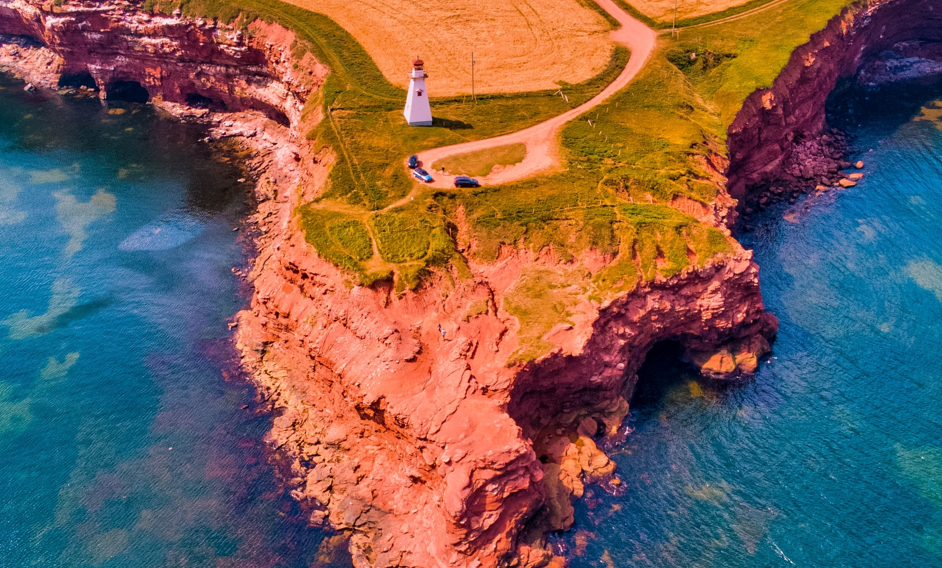The roads from Glasgow to Aberdeen are studded with castles—and often very narrow.
By Lola Augustine Brown
The 30-minute drive south from Aberdeen to Dunnottar Castle was postcard pretty, all sunlit rolling green fields divided by ancient granite rock walls. The green was broken by sunshine-yellow gorse flowers and cloud-fluffy sheep with baby lambs frolicking around them. Every so often I’d glimpse the glittering blue-grey of the North Sea from the highway.
I knew from the pictures I’d seen of Dunnottar Castle that it was going to be dramatic, but I’d visited two castles the previous day and another the day before that and wasn’t expecting the impact that this one would have.
Perched on a rocky headland, the ruins of this medieval fortress are in such good shape that from a distance, one would think people were living there. Dunnottar Castle is a marvel and well worth the climb down many, many steps to the beach and then up the steep narrow path to access it.
The castle is huge and warren-like, with rooms leading into more rooms—bedrooms, kitchens, cells, dining halls. I could make out fireplaces and peeked through the windows of the stables for a view of the beach 160 feet (49 metres) below at the base of the cliffs. A climb to the tower provided yet more spectacular views out over the ruins to the sea. There’s a large cistern in the middle of the ruins that was the castle’s source of water.
The Viscount and Viscountess of Cowdray, Weetman and Annie Pearson, bought the castle in 1925 in order to save it and opened it to the public. The dining room was restored, but the rest is romantically ruined. Plaques on the walls tell stories of the castle’s history—there was a fort constructed at Dunnottar in the 3rd century, a church consecrated there in the 4th, and a castle that was destroyed in the 9th century by the Vikings, who also killed King Donald II of Scotland while they were in the area. Thinking of the lives lived and the blood shed on that ground made me shiver. Then, from a formerly cloudless sky came a shower of ice pellets, and I knew it was time to leave. I huffed and puffed my way up all those stairs back to the car park and carried on with my journey.
It was lunchtime, and I’d been told by several people I’d met in Aberdeen that I’d find the “best fish and chips ever” in nearby Stonehaven, a quaint fishing town with a long pebble beach and a market square. Parking in the town, I walked along the beach to the harbour, thankful the ice pellets had stopped and ignoring the whipping wind.
Ordering a small fish supper (if you add the word supper to any order in Scotland, it’ll come with chips) from The Bay Fish and Chips, I sat at a table on the promenade to dig in. The haddock was flaky and rich in a light and crispy batter, the hand-cut chips perfectly fried. I devoured my supper and washed it down with a can of Irn-Bru—the fruity, fizzy, bright-orange soft drink that everyone in Scotland seems to drink. A massive gull eyed my box of food from the promenade railings, perched above a sign that read “do not feed the seagulls.”
After exploring the town, which is a mix of touristy shops and essential services such as butchers, bakers, and other necessities of life miles from the nearest city, I set off for Glasgow, where my visit to Scotland had begun a few days earlier.
Glimpses of Glasgow
The initial goal of my trip had been to visit Aberdeen and the Scottish Highlands, but taking advantage of a WestJet service that took me directly from Halifax to Glasgow in just over five hours, I was determined to enjoy the best of that city in the day and a half I had there. Flying overnight, I hit the ground running, dumping my bags at the posh and delightfully old-fashioned Grand Central Hotel and then heading out to explore.
Eager to stretch my legs after the flight, I walked a couple of kilometres to the Glasgow Cathedral and Necropolis. Considered one of Scotland’s most important examples of medieval architecture, the cathedral is the oldest building in Glasgow. It was built between the 13th and 15th centuries and is the only cathedral in the country to come through the Scottish Reformation of 1560 intact.
The Victorian Glasgow Necropolis, which sits on a low hill behind the cathedral, is huge—the final resting place of approximately 50,000 Glaswegians—and ornate. The monuments range from simple to showy, and the inscriptions say so much. I was impressed by those that proclaimed they were erected by friends of the deceased as marks of respect, and I chuckled at the inscription on Wee Willie Winkie author William Miller’s grave that lauded him as “the laureate of the nursery.”
From there, I took a taxi back to town to visit The Lighthouse, Scotland’s Centre for Design and Architecture, as I wanted to check out the permanent exhibition on Charles Rennie Mackintosh, the Scottish architect and painter. I’d always loved his designs, but until that moment had no idea that he had lived in extreme poverty and was truly recognized only many years after his death. The exhibition had copies of letters in which he’d begged friends to buy his watercolours, as he needed the money. I climbed the water tower there that was the product of his first commission and marvelled at how unique his designs are.
Finally, I was able to check into my room and take a little nap before joining the food and history walking tour I’d booked. I met Rebecca Anderson, the guide with Eat Walk Glasgow, outside my hotel, where we were joined by two lovely American women.
The first stop was Alston Bar and Beef, hidden underneath Glasgow Central Station (to which my hotel was attached). We enjoyed a small portion of dry-aged steak and chips in rich gravy as Anderson explained how the station and hotel were built and their significance to the city. From there, we walked along Buchanan Street, the main shopping street in the city, where chain stores are housed in grandiose historic buildings, and along cobbled side streets that led to squares, where Anderson pointed out areas of architectural and historic importance.
We ate locally sourced oysters in a plush, historic, converted drawing room at Hutchesons City Grill and chatted like old friends over cocktails. Next, we stopped at the Babbitty Bowser pub for haggis with neeps and tatties (and, yes, I rather enjoyed the haggis). Marching onwards with full bellies, we stopped at Mharsanta, a restaurant specializing in Scottish cuisine, for carnachan—a dessert made with whipped cream, honey, raspberries, and whisky (just as delicious as it sounds).
Our final stop of the tour was the Corinthian Club, a sprawling bar, restaurant, club, and casino complex set in an old Victorian bank. It’s a beautiful building, with a 26-foot-high glass dome and many original features. We were there to sample local cheeses and cider, though I opted for tea to help me get through the huge plate of Arran cheddar, Blue Murder, and other local cheeses served with oatcakes. It had been a wonderful tour, and I was both stuffed and exhausted at the end of it. My room at the Grand Central Hotel was quiet and luxurious, just perfect for sleeping like a log.
Walking to breakfast in the hotel takes you past huge framed photos of famous guests who’ve stayed at the Grand Central, which was built in 1883 and was long considered the swankiest hotel in town. There was Roy Rogers and Trigger (though apparently Trigger was moved to the Glasgow Police stables after he bit one of the hotel staff), Gene Kelly, Winston Churchill, JFK, Laurel and Hardy, and a host of royals.
A plaque in the lobby informs visitors that on May 24, 1927, the Scottish engineer John Logie Baird transmitted television pictures over telephone lines from London to the hotel.
The Grand Central’s classic champagne and oyster bar looks out over the ornate Victorian station. The breakfast buffet was plentiful and featured lots of locally sourced products, including haggis. I had a car booked for 10 a.m. for my drive up to Aberdeen, and I was both excited and filled with dread: I’d never before driven on the left side of the road.
Keep Left for Castles and Views
Despite my panic, the driving wasn’t that hard—even driving the rental car out of the lot in a busy city. Motoring along the highway out of Glasgow was fine—though I made a few wrong turns, I stayed on the left and the car’s GPS helped me find my way. There was no moment when I relaxed into the drive, though, and I had that driving-through-a-snowstorm adrenaline coursing through me at all times.
My first stop was to be Braemar, a village about two hours and 20 minutes north of Glasgow.
Spring had sprung on the Snow Roads Scenic Route—a 145-kilometre (90-mile) stretch that was all rolling hills in hues of purple and grey, lush fields studded with sheep and ruddy-brown Highland cattle, and granite farmhouses and tiny villages.
Driving to Braemar was where things got a bit hairy, when the roads sometimes narrowed to a single lane with passing spots; I drove white-knuckled hoping no car would come the other way—I was lucky: none did.
Just as I pulled into the parking lot of the historic Fife Arms Hotel, where I was stopping for lunch, the heavens opened and cold torrential rain started down. Safe and warm in the hotel bar, which was all tartan and taxidermy, I lingered with a book and ate a juicy Highland beef and bone-marrow burger. The rain showed no sign of letting up, so I made my way to Braemar Castle.
Owned by the chief of Clan Farquharson, Braemar Castle dates to 1628 and is a fairy-tale fortress of turrets and towers that has become a museum showcasing how the last inhabitants of the castle lived in the years just following the Second World War. I picked up a headset for a self-guided tour and loved the fact that such a grand place had really just been a home through the centuries. Braemar is a small castle, though, and it wasn’t long before I was back on the road, heading for my next hotel in the town of Banchory, 40 minutes southwest of Aberdeen. The rain was relentless, and I was glad to check in early and decompress from the driving.
Tor Na Coille is a gorgeous country house hotel set in woodlands. My room was huge, dressed in pale blue Harris Tweed and rich linens, and the bathroom had a claw-foot tub. The king bed was temptingly comfortable, the rain thrummed the windows, and I sank into a nap before dinner. At the hotel’s award-winning restaurant, I feasted on farmhouse terrine with a black pudding bonbon (delicious), and then, as I was still stuffed from lunch, skipped the main course for a cheese plate. Coffee came with a plate of handmade chocolates, and I lingered there a while, eating and watching the rain drench the lush gardens outside. I had no desire to go back outside in that weather and so opted for a blissful early night to counter my road-weariness.
The next morning, I set off for Crathes Castle, completed in 1596 and set within manicured grounds with a marvellous walled garden. I had a tight schedule and was a bit miffed to find out that the only way to see the castle was with a guided tour that ran every hour, and that I’d just missed the start of one.
But when I did tour the castle with my kilted guide, Ron Nairn, I found it worth the wait. The castle was huge and contained such unique artifacts that one really did need a guide to see them all properly. There was a hunting horn from 1323; painted 16th-century ceilings bearing witty life lessons such as “As the dog returneth to his old vomit, so the fool return to his old foolishness” emblazoned alongside them; and the Baronetage of Nova Scotia granted to Clan Burnett, who owned the castle, along with 16,000 acres of land (they never took possession, though, because of wars with the French).
I was supposed to be in Aberdeen for lunch but didn’t finish at Crathes Castle until 1 p.m. and then it was on to Drum Castle. Built in the 13th century, Drum Castle is one of the oldest tower houses in Scotland, and it is huge, with a cobbled courtyard and a family chapel half-hidden in the trees. Asking to just have a walk around instead of joining a guided tour, I explored the many rooms and halls of Drum Castle, marvelling at the library and its 4,000 books, and adoring the art and artifacts that filled the rooms. Then I was off to Aberdeen—better late than never.
Glimpses of The Granite City
Driving into Aberdeen late in the afternoon and knowing I’d have only a day to explore, I was determined to cross a few attractions off my list that day. First, I wanted to walk on the beach.
Driving into the beach promenade is where I made my only real mistake driving on the left side, turning into the wrong lane. Thankfully, there were no cars in the lane, but I was serenaded by honking horns and shown a few hand gestures. Mortified, I parked in front of the beach and walked along the golden sands until the brutal winds whipped me back to the car. The rain had begun again, so I went to check into my hotel and calm down a bit.
Behind its grand granite facade, the Chester Hotel was modern and luxurious, with a rainfall shower and big comfy bed. I decompressed a little, then walked into the city centre, past magnificent homes and 17th-century halls and civic buildings, and browsed the shops there. They call Aberdeen “The Granite City,” and every single building does in fact seem to be built of granite, which is very impressive and gives the whole city a very posh air.
I was determined to try a “buttery” while in the city, which is a savoury bread roll special to the area that I’d read about in the crime novels of Stuart MacBride (which are all set in Aberdeen). I tracked down Thain’s Bakery, which was founded in 1962 and is famous for its pies, and ordered a buttery (also known as a rowie, should you ever want one), which was flaky, buttery indeed, and delicious. I also bought a meat pie for good measure, which was so delicious that I wanted another immediately after I more or less inhaled it. Instead, I went back to the hotel for a delicious meal of local scallops and a fat Highland beef steak.
I spent my morning in Aberdeen exploring the medieval old city and the university campus, walking cobbled streets, and marvelling at how Hogwarts-like the campus was (it was founded in 1495). There are even two fairy-tale turrets on gateposts across from King’s College Chapel (built in the late 15th century), though they were a fairly late afterthought, having been added in 1833.
I was desperate to have more time to explore Aberdeen, but I had to get to Dunnottar Castle and then back to Glasgow.
As brief as my whirlwind visit was, the Scotland I saw stole my heart a little—and would likely steal a part of yours, too.
Pictured above: Dunnottar Castle in autumn
Photo: iStock/Susanne Neumann.





